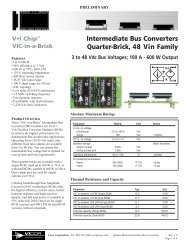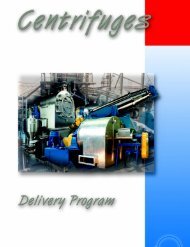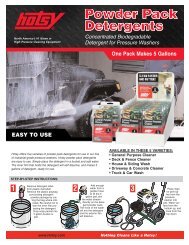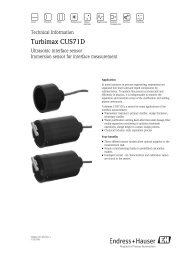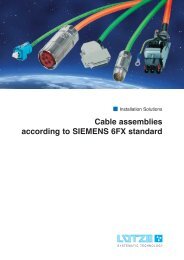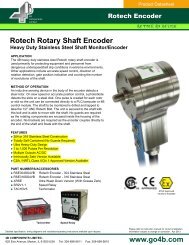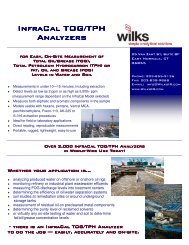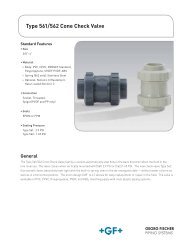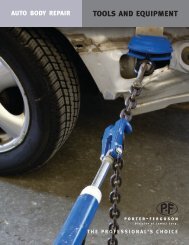VABS Technology Sheet (Composite Beams).pdf - iMechanica
VABS Technology Sheet (Composite Beams).pdf - iMechanica
VABS Technology Sheet (Composite Beams).pdf - iMechanica
Create successful ePaper yourself
Turn your PDF publications into a flip-book with our unique Google optimized e-Paper software.
TM<br />
Efficient High-Fidelity Modeling of <strong>Composite</strong>s—A New Approach<br />
Efficient. Accurate. Versatile.<br />
Overview<br />
<strong>VABS</strong> is the only tool capable of rigorously modeling threedimensional<br />
(3D) slender solids (commonly called beams) with<br />
complex microstructures and is becoming the tool of choice<br />
for the wind turbine and helicopter industries after 20 years’<br />
development. Researchers and engineers worldwide are actively<br />
using <strong>VABS</strong>, which is the standard tool for design and analysis<br />
of composite slender structures such as wind turbine blades,<br />
helicopter rotor blades, high aspect ratio wings, composite<br />
bridges, and other slender structural components. The unique<br />
technology underlying <strong>VABS</strong> renders it the first truly efficient highfidelity<br />
modeling tool for composite beams, saving users many<br />
orders of magnitude in computing time relative to 3D FEA (finite<br />
element analyses), without a loss of accuracy. The advantages of<br />
<strong>VABS</strong> over other technologies have been clearly demonstrated by<br />
virtue of its generality, accuracy, and efficiency.<br />
Unique <strong>Technology</strong><br />
<strong>VABS</strong> (Variational Asymptotic Beam Sectional Analysis)<br />
implements the various beam theories based on the concept<br />
TM<br />
of simplifying the original nonlinear 3D analysis of slender<br />
structures into a one-dimensional (1D) nonlinear beam analysis<br />
using a powerful mathematical method, the variational asymptotic<br />
method. <strong>VABS</strong> is designed to model structures for which one<br />
dimension is much larger than the other two (i.e., a beam-like<br />
body), even if the structures are made of composite materials and<br />
have a complex internal structure. <strong>VABS</strong> takes a finite element<br />
mesh of the cross section including all the details of geometry and<br />
material as inputs to calculate the sectional properties including<br />
structural properties and inertial properties. These properties are<br />
needed for the 1D beam analysis to predict the global behavior of<br />
the slender structure. The 3D pointwise displacement/strain/stress<br />
distribution within the structure can also be recovered based on<br />
the global behavior of the 1D beam analysis.<br />
Key Benefits<br />
++ Unprecedented competitiveness as the only available<br />
technology to rigorously model real structures such as<br />
composite blades<br />
++ Drastically reduced design cycle and time to market by helping<br />
you save many orders of magnitude in engineering design and<br />
analysis time<br />
++ The best compromise between accuracy and efficiency, an<br />
effective alternative for computation-intensive 3D FEA<br />
++ An enabling technology for nonlinear aeroelastic analysis of<br />
highly flexible structures
Applications<br />
++ Wind turbine blades<br />
++ Helicopter rotor blades<br />
++ Gas turbine blades<br />
++ High aspect ratio wings<br />
++ Wing section design<br />
++ <strong>Composite</strong> bridges<br />
++ Other general composite/smart structures:<br />
• <strong>Beams</strong><br />
• Shafts<br />
• Rods<br />
• Columns<br />
• Bars<br />
Materials<br />
<strong>VABS</strong> is not restricted by materials. The structure<br />
can be made of an arbitrary number of general<br />
materials including:<br />
++ Fiber reinforced composites<br />
++ Woven composites<br />
++ Braided composites<br />
++ Conventional materials<br />
++ Foam materials and others<br />
Efficient High-Fidelity<br />
Enabled by <strong>VABS</strong>, analysis can be done as efficiently and simply<br />
as conventional beam analysis, without losing accuracy compared<br />
to more complex and time-consuming 3D FEA. With <strong>VABS</strong>, it is<br />
now possible to confidently design and analyze real structures<br />
with complex microstructures due to this unique efficient highfidelity<br />
feature of <strong>VABS</strong>. For example, structures as complex as<br />
real composite rotor blades with hundreds of layers can be easily<br />
handled by a laptop computer.<br />
Versatile<br />
<strong>VABS</strong> is implemented using the finite element techniques with a<br />
general element library that includes all the typical 2D elements<br />
such as 3, 4, 5, 6-noded triangular elements and 4, 5, 6, 7, 8,<br />
9-noded quadrilateral elements. Users are free to choose the type<br />
of elements, and different types of elements can be mixed within<br />
one mesh, if necessary. This flexibility allows <strong>VABS</strong> to model<br />
beams of any shape.<br />
<strong>VABS</strong> can deal with arbitrary layups. Users can provide one<br />
parameter for the layup orientation and one parameter for the ply<br />
orientation to uniquely specify the material system in the global<br />
coordinate system. Nine parameters can be used for the ply<br />
orientation if a ply is highly curved and the ply angle is not uniform<br />
within an element.<br />
<strong>VABS</strong> does not require the beam reference line to be the locus of<br />
cross-sectional area centroids. <strong>VABS</strong> can calculate the centroid<br />
for any arbitrary cross section, and users can choose their own<br />
reference line for the convenience of the 1D global beam analysis.<br />
<strong>VABS</strong> can deal with isotropic materials, orthotropic materials, and<br />
general anisotropic materials.<br />
<strong>VABS</strong> can be quickly and conveniently integrated with other<br />
environments such as computer-aided design environments,<br />
multidisciplinary optimization environments, or commercial<br />
finite element packages.<br />
Additional Features and Benefits:<br />
1. Shape of the cross-section: Truly arbitrary geometries<br />
accommodated. Modeling of realistic rotor blades is<br />
only possible through <strong>VABS</strong>. No need of oversimplified<br />
approximation for real structures.<br />
2. Material properties: <strong>VABS</strong> has no restrictions on material<br />
properties and can handle any material including isotropic,<br />
orthotropic, or general anisotropic materials.<br />
3. Multiphysical capability: <strong>VABS</strong> can analyze structures<br />
under the coupled effects of thermal, mechanical, and<br />
electromagnetic fields.<br />
4. Various engineering beam models: Generalized Euler-<br />
Bernoulli model, generalized Timoshenko model to account<br />
for transverse shear, generalized Vlasov model for composite<br />
beams with significant restrained warping effects. No ad-hoc<br />
assumptions such as plane sections remaining plane and<br />
normal to the beam axis are invoked.<br />
5. Modeling of initially curved/twisted/oblique beams: The<br />
structure can be initially twisted or curved and/or have a<br />
naturally oblique cross-section.<br />
6. Recovery of field variables: Possible to accurately recover 3D<br />
stresses, strains, and displacements from 1D displacements<br />
and sectional resultants.<br />
7. Free companion 1D beam analysis: GEBT, also developed<br />
by Prof. Yu as a companion code for <strong>VABS</strong>, is a generalpurpose<br />
1D nonlinear beam analysis code. It is based on the<br />
geometrically exact beam theory and can be used for static,<br />
dynamic, eigenvalue analysis.<br />
8. Trapeze effect: Carries out a nonlinear sectional analysis<br />
to incorporate the trapeze effect for beams under large<br />
centrifugal forces which effects the torsional rigidity.<br />
9. Overall benefits: Very high levels of accuracy—comparable<br />
to 3D nonlinear FEA yet with the efficiency of simple 1D<br />
beam analysis. Possible to design/analyze complex<br />
structures which is not possible using 3D FEA within<br />
available computing resources.<br />
Contact us for<br />
a free trial<br />
Phone: 801.599.5879<br />
FAX: 435.797.9612<br />
Email: info@analyswift.com<br />
Web: www.analyswift.com<br />
TM




